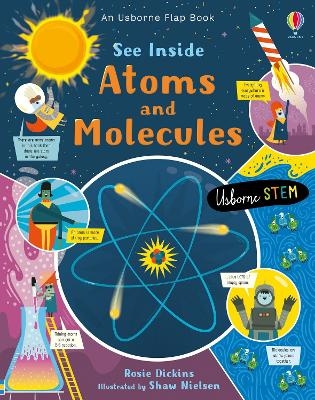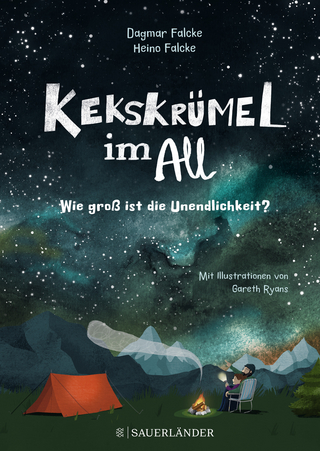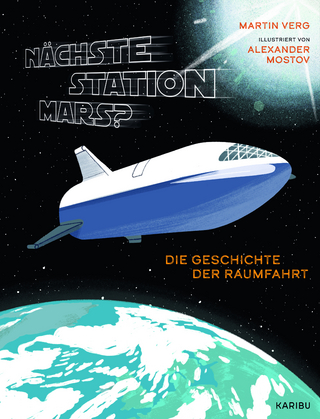
See Inside Atoms and Molecules
Usborne Publishing Ltd (Verlag)
978-1-4749-4364-2 (ISBN)
Rosie Dickins (Author) Rosie Dickins grew up in England and Hong Kong. An avid reader, she always loved dreaming up her own stories. After studying literature at Oxford University, art in Paris and plenty of travelling, she settled in London, where she works for Usborne Publishing. She has written over a hundred children's books, from award-winning information books to fiction.
1 What is an atom?
An atom is a tiny particle that is too tiny to see unles you use a high-powered microscope. Billiions and billions of atoms make up everying including you. The idea of atoms was put forward over 2,000 years ago by a Greek thinker called Democritus. An atom by itself is known as an element.
2 Inside and atom
Most of an atom is just empty space. In the middle of the atom, sits a solid part called the nucleus. The nucleus is a cluster of tiny particles called protons and neutrons which give the atom some weight. Even tinier pariticles called elctrons whiz around the nucleus and they have no weight at all. Protons have a positive charge, electrons have an negative charge and neutrons do not have any charge.
3 Joining together
Most atoms will join up with other atoms to form molecules and compounds. Electrons enable atoms to join together and they orbit atoms in layers or shells. Atoms like to have full shells which can lead to them sharing or stealing electrons.
4 Getting in a state
Substances can exist in three different states: solid, liquid or gas. Something's state can be changed by changing its temperature: atoms and molecules gain nore energy when something becomes hotter and they lose more energy when they become colder. Solids can be turned into liquids without adding heat by dissolving it.
5 FIZZ, WHIZZ, BANG
Chemical reactions happen when atoms and molecules react with each other to form a new substance. Exotheric reactions occur when the reaction throws out a lot of heat and energy. Endothermic reactions need energy for them to happen.
6 Where do atoms come from?
Scientists think that atoms were formed in the gigantic explosion known as the Big Bang. Our Sun is so bright and hot because of nuclear fusion which happens when atoms merge together. Nuclear power stations use the process of nuclear fission when using heat to make electricity. Nuclear fission involves the splitting apart of big atoms into smaller ones, throwing out large amounnts of heat and light.
7 All the elements
The Periodic Table of the Elelments shows every type of atom in the order of how many protons each has. It was created inb the 1860s by Dmitri Mendeleev who said that the idea came to him in a dream. The table could be extended in the future if bigger, heavier atoms are made by scientists.
8 Amazing atoms
Some atoms today have been around since the beginning of the universe. Scientists developed the theory of quantum mechanics which says that looking at tiny things changes them, making some effects impossible to see. Carbon dating is when carbon atoms are used to find out how old something is. Atomic clocks accurately measure time using vibraring Caesium atoms.
9 Miraculous molecules
The smallest molecule has only two hydrogen atoms. The biggest artificial molecule is known as PG5. DNA is the longest natural molecule. A Buckeyball is made of carbon atoms and has many uses including in medicine and in electronics. A protein molecule found in vampire-bat saliva, known as Draculin, helps to stop blood from clotting.
| Erscheinungsdatum | 23.12.2019 |
|---|---|
| Reihe/Serie | See Inside |
| Illustrationen | Shaw Nielsen |
| Verlagsort | London |
| Sprache | englisch |
| Maße | 223 x 276 mm |
| Gewicht | 580 g |
| Themenwelt | Kinder- / Jugendbuch ► Sachbücher ► Naturwissenschaft / Technik |
| Kinder- / Jugendbuch ► Spielen / Lernen | |
| Schulbuch / Wörterbuch | |
| ISBN-10 | 1-4749-4364-0 / 1474943640 |
| ISBN-13 | 978-1-4749-4364-2 / 9781474943642 |
| Zustand | Neuware |
| Haben Sie eine Frage zum Produkt? |
aus dem Bereich


